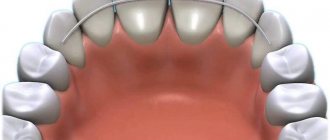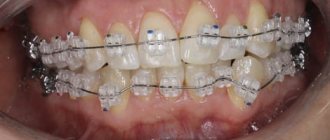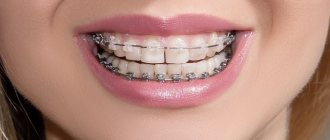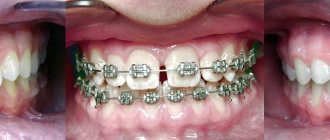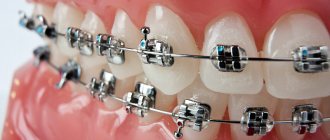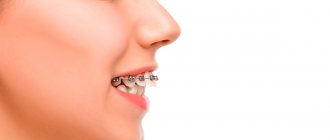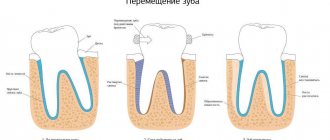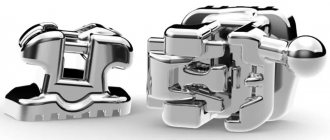A luxurious snow-white smile is a permanent trend of our time. However, not everyone is lucky enough to have naturally straight and healthy teeth. Ashamed of their smile, many people endure awkwardness for years, get used to expressing emotions sparingly and live in isolation. But in vain! Modern brace systems allow you to perfectly and discreetly straighten your teeth, and some models of braces can even become a real decoration for your smile during the treatment period.
If you are no longer ready to put up with crooked teeth and decide to act, an experienced orthodontist will assess the severity of the defects and propose an optimal correction plan. An important factor when choosing a bracket system is the aesthetic appearance of the finished structure and its cost. Knowing the features and nuances of various braces, you will make the right choice and get the desired result.
Which bracket system to choose and what results to expect – read our article.
What are braces and how do they work?
Orthodontic braces, also known as braces, are permanent structures designed to correct the bite and eliminate defects in the dentition. Their effect is based on the force of resistance, when special bracket system plates are fixed with locks on the outer or inner surface of the teeth, and the metal arch connecting them steadily returns to the specified position, slowly but surely aligning the teeth in a row.
The effect of any braces on the teeth is a small but constant pressure, and during the therapy the orthodontist will loosen or tighten them more, will use arches of different shapes and thicknesses - this will allow you to change the degree of pressure and ultimately achieve the correct position of the teeth. Under the influence of braces, not only the teeth, but also the surrounding bone tissue experiences pressure; braces trigger the process of its remodeling. This happens very slowly, which is why in some cases braces must be worn for up to three years to achieve optimal results.
All bracket systems are classified as follows:
- by material of manufacture: polymer, metal, plastic, combined or sapphire;
- according to the method of connecting the plates to the arc: ligature (classical) and non-ligature (self-regulating);
- according to the place of attachment: vestibular (external), lingual (internal).
Vestibular and lingual – which is better?
First, let's compare braces based on where they are attached to the teeth. Each orthodontic design has its own indications, advantages and disadvantages. And despite the fact that any braces are designed to solve the main problem - correcting the bite, it is worth carefully considering the options in order to choose the best one.
Vestibular braces - a familiar classic
Vestibular braces are fixed on the front surface of the teeth and are considered the most popular in modern orthodontics. Such designs do not lead to impaired diction and are easy to maintain. The duration of therapy using the vestibular system depends on the severity of the defects. Since the external brace system is very noticeable on the teeth, the choice of materials for its manufacture must be approached very responsibly:
- metal is a reliable and at the same time very noticeable material on the teeth; many patients note its unaesthetic appearance;
- plastic is a more fragile but aesthetic material, the color of which can be selected in accordance with the natural color of the enamel, has a low cost and is often used in the manufacture of budget braces for the correction of minor defects in children and adults;
- ceramics are a more expensive alternative to plastic; ceramic structures are aesthetically pleasing and hypoallergenic;
- sapphire is the most durable, aesthetic and expensive material; sapphire braces are transparent and almost invisible on the teeth.
Some patients say the main disadvantage of vestibular braces is the inability to completely close the mouth after installation. It is worth noting that such an effect is indeed possible in case of serious bite pathologies or if the system itself is selected incorrectly.
Lingual braces are the second most popular
At one time, lingual braces replaced vestibular braces; they are fixed on the inner surface of the teeth; for their installation, a special base is made that replicates the anatomical structure of the patient’s teeth. Lingual systems are more expensive than classic ones and more difficult to manufacture, but it was their appearance that eliminated the main problem of conventional vestibular systems, because unlike them, lingual braces became almost invisible.
In recent years, some types of braces, including lingual ones, have seriously improved - they have become thinner
,
light
and hypoallergenic.
3 main advantages of lingual systems:
- They are not noticeable. And this is really a big plus of lingual structures, because in order to notice them, a person must either look closely at your jaw, or simply know that the braces are installed from the inside and specifically pay attention to this.
- When creating lingual braces, 3D modeling technology is used. This means that the predicted result of therapy can be seen even before it begins.
- Throughout the entire treatment period, the orthodontist, together with the patient, can make adjustments to the design. Classic braces do not offer this possibility.
5 main disadvantages of lingual braces:
- Therapy with lingual braces is quite painful, even compared to classic ones.
- When correcting an overbite with lingual braces, diction is seriously affected. Since the system is fixed from the inside, from the side of the tongue, it becomes very difficult to pronounce familiar words. The so-called logoneurosis may even develop, when the patient loses patience and becomes very nervous due to the fact that the usual sound pronunciation becomes inaccessible to him.
- Parts of lingual braces can injure the tongue, especially at the initial stage of treatment.
- Therapy using internal braces lasts longer than with vestibular braces.
- There are restrictions for adult patients in certain types of intimacy. As we mentioned above, lingual braces can injure the patient’s tongue, but this warning also applies to his sexual partner - any sensitive mucous membrane is at risk. Doctors do not always warn about this disadvantage of lingual braces, but this does not eliminate the problem itself.
As you can see, despite a number of advantages and high cost, lingual braces are not indicated for all patients and have a number of features. Wear invisible braces, but put up with the inconvenience or choose a vestibular system - it’s up to you.
Final stage
This stage involves fixing the location of the teeth, establishing a high-quality relationship between them, so that after removing the braces they remain in a stable position. Here it is important to think about purchasing retainers; they will be needed at the final stage of treatment. In fact, the final effect depends on how correctly the patient uses this device.
Invisible braces. Result before and after treatment
Now you need to visit a specialist more often: one visit/month to achieve the goal set at the beginning of treatment. Sometimes clients ask to be allowed to remove their braces more quickly because they experience fatigue associated with wearing them. Haste in this case is a bad help. To ensure that the efforts made over a long period of time are not in vain, the patient should be patient and force himself to hold out until the moment when the orthodontist, based on the findings of the next examination of the oral cavity, decides to stop using the braces system.
The result of treating malocclusion with braces
Treatment may last longer than planned. It is necessary to take into account the fact that braces are removed by specialists only when the person conscientiously followed all the instructions, methods of maintaining cleanliness and quality of work, and came to all the checks that were discussed in advance - all this in most cases cannot be clearly foreseen in advance.
Ligature and non-ligature - what's the difference?
Do you remember that the main elements of the design of braces are plates (overlays on the teeth with locks) and an arch? Let us now compare braces according to the method of connecting the plates to the arch - they are ligature and non-ligature.
Ligature
It is ligature braces that are considered classic in orthodontics; their use is an old and proven method of occlusion correction. Due to their high efficiency, ligature systems are still relevant today. With the help of ligatures, you can correct the most complex pathologies, including mesial, distal, open or deep bites.
Ligatures are small wires with which a power arc is fixed to each clasp on the surface of the tooth. Typically, ligatures are used at the initial stage of therapy, and later, after slightly weakening the structure, they are replaced with special rubber bands. \
Advantages of ligature braces:
- effective correction of any malocclusion;
- the ability to use colored rubber pads and create stylish individual brace systems;
- low cost.
Flaws:
- massive structure;
- risk of damage to the oral mucosa;
- long period of patient adaptation to the design;
- long period of treatment;
- The ligature makes the braces very noticeable.
Unligated
In the course of work to improve orthodontic treatment methods, non-ligature (self-regulating) braces were developed - modern designs that are distinguished by fixing the arch to the clasps. Thanks to a special fixation system, the load on the metal arch is reduced and the teeth move with less force. The advantages of such a system allow patients to endure the entire period of therapy much more comfortably.
Ligature-free systems have a number of advantages:
- a fairly simple process of installation and subsequent correction;
- shortened therapy period;
- gentle effect on the dental system;
- fast adaptation;
- minimal risk of complications;
- basic hygiene care;
- Periodontal diseases are not a contraindication for the installation of such a system;
- smaller size compared to ligatures;
- the designs are aesthetic and almost invisible on the teeth.
And some disadvantages:
- they are not used to correct complex malocclusions;
- have a high cost.
Which systems are better - with or without a ligature?
There is no clear answer to this question. From an aesthetic point of view, the best ones are those without ligature. For example, the H4 self-adjusting bracket system (OC Orthodontics) is considered one of the most aesthetic, and due to its variability and low profile, also the most effective.
It is important to understand that the main task of any brace system is to straighten the dentition and correct the bite, therefore, to correct uncomplicated anomalies, a system without a ligature is suitable, but to eliminate serious defects you will have to choose a traditional ligature design.
Only a competent orthodontist can choose the ideal braces for a patient, taking into account his individual dental characteristics, age and lifestyle.
Result after one year of treatment
12 months after the start of treatment, the correction of the bite does not stop. A stage begins that is even more complex and painstaking than before. Do not forget that the duration of treatment is directly proportional to the level of defects in the dental system: some are lucky to wear it for about six months, others need to wear it for about a year or even more. At this stage, the small gaps between the patient's teeth begin to decrease - the rows gradually take on an ideal shape.
What material for braces should I choose?
Modern braces systems can be not just functional, they can be aesthetic, stylish, bright or transparent. This is possible thanks to the use of materials with different properties: plastic, ceramics, sapphire, simple or precious metal
. The properties of the listed materials are different; the choice of a specific one depends on the age of the patient, his preferences regarding aesthetics and structural strength, as well as financial possibilities.
| ceramics | metal | sapphire |
If you need a quick and inexpensive correction, you can opt for a metal structure; if long-term correction is expected, and the patient’s lifestyle requires publicity, it is worth considering ceramic or sapphire braces.
How long does it take to install braces?
The process of manufacturing and installing braces usually takes about a week and includes the following steps:
- drawing up a treatment plan: for a more accurate assessment of the patient’s dental system, the doctor does a computed tomography scan, prepares impressions of the jaw and, together with the patient, selects the optimal type of brace system.
- Complete sanitation of the oral cavity: at the initial stage it is necessary to remove carious lesions and eliminate inflammation. If the doctor understands that some teeth will interfere with the necessary displacement of the dentition, they are removed.
- Manufacturing of braces: at this stage, laboratory specialists select template designs or manufacture individual bracket systems.
- Installation: braces are fixed on the surface of the teeth using a special fluoride-containing glue and adjusted to all parameters.
Of course, it will take a week to get used to braces. After installation, the doctor will tell you in detail how to properly care for them, what food you will have to give up during the treatment period, so that the tooth enamel under the braces does not break down and lose its natural color.
If you decide to install classic ligature braces, be prepared to visit the orthodontist approximately once a month, during these visits the doctor will manually change the position of the metal arch.
Leveling cost
The costs of such a complex orthodontic service as teeth straightening with braces consist of the sum of prices for consultation, diagnostic studies, sanitation and professional oral hygiene, the brace system itself and its installation, each system correction procedure, removal of the structure and restoration procedures, retainer and retention record.
Prices and payment systems in different clinics differ significantly; even the doctor does not know exactly how long the device will need to be worn, what additional devices and manipulations may be needed during treatment, so it is impossible to immediately calculate the exact total cost.
The cost of the braces themselves is influenced by the material, type, variety and manufacturer of the design. Systems made in the USA and Germany are considered the most reliable, efficient and aesthetically pleasing, but they are much more expensive than domestic ones.
- The cheapest ones are ligature braces made of metal or plastic, on average $300-600 per row of teeth.
- Self-ligating systems made of ceramic or sapphire will cost more, on average $500-1200 per row.
- The most expensive lingual systems, made taking into account the individual characteristics of the patient’s teeth, cost an average of $1000-2000.
Installation, depending on the complexity of the system and the labor intensity of the doctor’s work, can cost 30-50% of the total treatment amount. The cost of all other procedures should be found in the price list of a specific clinic and clarified after an examination by a doctor, since the condition of the teeth, the complexity and number of elements of the braces system will be different in each individual case.
At what age can you get braces?
Modern orthodontics allows you to solve the problem of crooked teeth and correct your bite at almost any age. It is most advisable to do this in young years, even before the final ossification of the jaws; the optimal time to begin bite correction in children is from 8 to 14 years. However, there are situations when correction is necessary for the patient in adulthood. Adults often seek correction of a bite that has been altered by the growth of wisdom teeth and subsequent displacement of adjacent teeth. Often the need for bite correction occurs after the removal of unhealthy teeth. The use of braces in such cases is the best way to eliminate defects.
BIBLIOGRAPHY
1. Sarver, D.: Interactions of hard tissues, soft tissues, and growth over time, and their impact on orthodontic diagnosis and treatment planning, Am. J. Orthod. 148:380–386, 2015. 2. Sarver, D. and Jacobson, R.S.: The aesthetic dentofacial analysis, Clin. Plast. Surg. 34:369-394, 2007. 3. Peck, H. and Peck, S.: A concept of facial esthetics, Angle Orthod. 40:284-318, 1970. 4. Schabel, BJ; McNamara, J. A. Jr.; Baccetti, T.; Franchi, L.; and Jamieson, SA: The relationship between posttreatment smile esthetics and the ABO Objective Grading System, Angle Orthod. 78:579-584, 2008. 5. Kokich, V.O.; Kiyak, A.H.; and Shapiro, PA: Comparing the perception of dentists and laypeople to altered dental esthetics, J. Esth. Dent. 11:311-324, 1999. 6. Kokich, V.O.; Kokich, V. G.; and Kiyak, H.A.: Perceptions of dental professionals and laypersons to altered dental esthetics: Asymmetric and symmetrical situations, Am. J. Orthod. 130:141- 151, 2006. 7. Auger, T. A. and Turley, P. K.: The female soft tissue profile as presented in fashion magazines during the 1900s: A photographic analysis, Int. J. Adult Orthod. Orthog. Surg. 14:7-18, 1999. 8. Schlosser, JB; Preston, C. B.; and Lampasso J.: The effects of computer-aided anteroposterior maxillary incisor movement on ratings of facial attractiveness, Am. J. Orthod. 127:17-24, 2005. 9. Desai, S.; Upadhyay, M.; and Nanda, R.: Dynamic smile analysis: Changes with age, Am. J. Orthod. 136:310.e1-310.e10, 2005. 10. Dickens, S.; Sarver, D. M.; and Proffit, W.R.: The dynamics of the maxillary incisor and the upper lip: A cross-sectional study of resting and smile hard tissue characteristics, Am. J. Orthod. 3:313-320, 2002. 11. Chetan, P.; Tandon, P.; Singh, G. K.; Nagar, A.; Prasad, V.; and Chugh, V.: Dynamics of a smile in different age groups, Angle Orthod. 83:90-96, 2013. 12. Beall, AE: Can a new smile make you look more intelligent and successful? Dent. Clin. N. Am. 51:289-297, 2007. 13. Shaw, W. C.; Rees, G.; Dawe, M.; and Charles, C.R.: The influence of dentofacial appearance on the social attractiveness of young adults, Am. J. Orthod. 87:21-26, 1985. 14. Tjan, A.H.; Miller, G.D.; and The, JG: Some esthetic factors in a smile, J. Prosth. Dent. 51:24-28, 1984. 15. Sabri, R.: The eight components of a balanced smile, J. Clin. Orthod. 39:155-167, 2005. 16. Hulsey, C.: An esthetic evaluation of lip-teeth relationships present in the smile, Am. J. Orthod. 57:132-144, 1970. 17. Ackerman, J.; Ackerman, M. B.; Brensinger, C. M.; and Landis, JR: A morphometric analysis of the posed smile, Clin. Orthod. Res. 1:2-11, 1998. 18. Pitts, T.: Bracket positioning for smile arc protection, J. Clin. Orthod. 51:142-156, 2021. 19. Proffit, W.R.; Fields, H. W.; Larson, B.; and Sarver, DM: Contemporary Orthodontics, 6th ed., Elsevier, Philadelphia, 2021, p. 160.20. Dickens, S. T.; Sarver, D. M.; and Proffit, W.R.: Changes in frontal soft tissue dimensions of the lower face by age and gender, World J. Orthod. 3:313-320, 2002. 21. Harris, E.F.; Hassankiadeh, S.; and Harris, JT: Maxillary incisor crown-root relationships in different angle malocclusions, Am. J. Orthod. 103:48-53, 1993. 22. Bryant, R. M.; Sadowsky, P.L.; Dent, M.; and Hazelrig, J.B.: Variability in three morphological features of the permanent maxillary central incisor, Am. J. Orthod. 86:25-32, 1984. 23. Van Loenen, M.; Degrieck, J.; De Pauw, G.; and Dermaut, L.: Anterior tooth morphology and its effect on torque, Eur. J. Orthod. 27:258–262, 2005. 24. Mavroskoufis, F. and Ritchie, G. M.: Variation in size and shape between left and right maxillary central incisor teeth, J. Prosth. Dent. 43:254-257, 1980. 25. Chaushu, S.; Sharabi, S.; and Becker, A.: Tooth size in dentitions with buccal canine ectopia, Eur. J. Orthod. 25:485-491, 2003. 26. Balut, N.; Klapper, L.; Sandrik, J.; and Bowman, D.: Variations in bracket placement in the preadjusted orthodontic appliance, Am. J. Orthod. 102:62-67, 1992.
They say wearing braces is painful...
Indeed, braces therapy very often causes discomfort, and reviews from patients who have gone through this procedure indicate that there is little pleasant about it. This occurs due to the pressure of braces on the teeth. If the patient has a low pain threshold, the orthodontist will not tighten the system too tightly and will prescribe painkillers for the first time. If, a week after installing braces, the pain intensifies and the temperature rises, you should immediately consult a doctor to find out the reasons.
In the first weeks after braces are installed, the patient may experience significant discomfort and pain throughout the jaw. This reaction is due to the gradual movement of the teeth into the desired position and is considered normal - you will have to be patient.
Immediately after installing braces, parts of the system itself can injure the mucous membrane and tongue; this problem can be solved by using special wax as prescribed by a doctor. Gradually you will get used to it and stop feeling discomfort, and after a while you will get beautiful, straight teeth and the much-desired snow-white smile!
